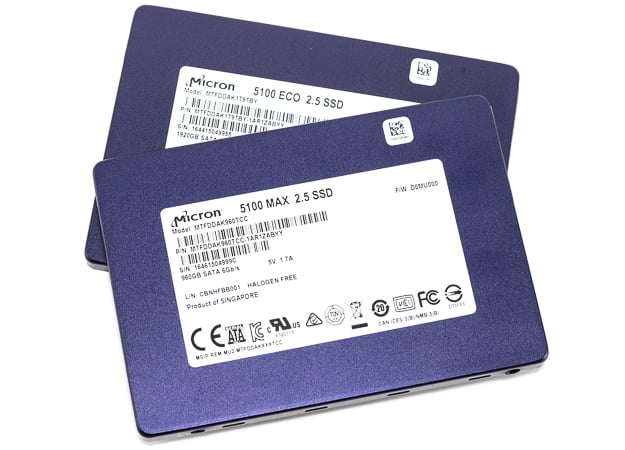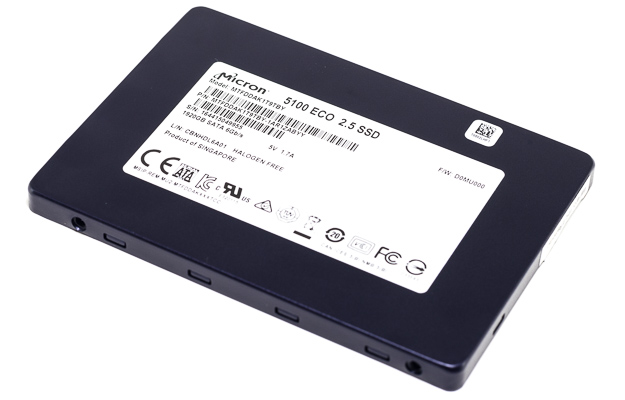Micron 5100 ECO and MAX SSD Review: High-Capacity, Affordable Datacenter Storage
Introducing Micron 5100 Series SSDs
As modern datacenters grow, so too do their demands. The processor race is heating up with both ARM and AMD vying to unseat Intel from its throne. Banks of RAM are beginning to become augmented by Intel’s Optane memory and other products leveraging 3D XPoint technology. However, some of the most interesting changes in the industry are happening where all this data is eventually stored.
Traditional hard drives have served the computing world well for more than half a century. In recent years, however, solid state storage has become increasingly attractive as it offers improvements over spinning media in virtually every regard. Solid state drives boast significantly faster read and write speeds than hard drives, particularly for non-sequential reads and writes. These random I/O operations are particularly important in datacenter settings where storage arrays are serving hundreds, if not thousands, of users at once. SSDs also bring significant power savings compared with HDDs as they have no moving parts. Less power draw also means less heat, and less heat means datacenter density can be increased without costly HVAC renovations.
Unfortunately for SSDs, hard drives continue to rule in terms of cost per gigabyte. Many, if not most, hard drives clock in at well under $0.05 USD per GB, a price point even budget SSDs are far from attaining. As it stands, SATA SSDs priced around $0.50 per GB can be considered a good value – an order of magnitude higher in cost. SSDs can still maintain a competitive total cost of ownership (TCO) thanks to the superior power efficiency and longer lifespans.
Helping tip these TCO scales in favor of solid state storage are Micron’s 5100 series SSDs which ship in three flavors: ECO, PRO, and MAX. These break down as follows:
Today, we have two of these drives gracing our testbench, a 960GB 5100 MAX and a spacious 1920GB 5100 ECO. These can both be considered the economical cousins of Micron’s 9100 MAX NVMe speed demon we reviewed last year. The 9100 MAX costs north of $1.00 per GB (around $1.35 per GB at the time of our review), while the 5100 ECO and MAX register at around $0.45 and $0.59 per GB respectively (NOTE: Prices can vary by volume and other factors).
Unlike the 9100 Series, which is built on MLC NAND flash, the 5100 Series utilizes cheaper 3D TLC NAND controlled by a 4-channel Marvell controller. TLC NAND is not typical in enterprise grade drives due to its tendency to wear out more quickly than MLC or SLC NAND. On the other hand, TLC NAND does facilitate higher capacities. So, what has Micron done to make their TLC drives enterprise ready? The answer is abundant over-provisioning.
Over-provisioning is the practice of providing additional raw capacity in a drive over and beyond the user formatted capacity. The extra “hidden” NAND is substituted into use as cells wear out which effectively increases lifespan. Most drives on the market with SLC or MLC NAND provide only a small margin of over-provisioning. Because 3D TLC NAND is so much cheaper, Micron can provide higher levels of over-provisioning while remaining cost competitive. The 5100 ECO drives possess around 10-20% over-provisioning, the 5100 PRO around 20-30%, and the 5100 MAX a whopping 60-70%.
How exactly this trade-off versus SLC and MLC NAND will pay off remains to be seen, as in either case the endurance is much too good for us - or anyone - to adequately test in a timely manner. The 5100 Series SSDs all share a mean time to failure (MTTF) of two million device hours – a hair over 200 years. Micron rates the 5100 ECO at up to one full drive write per day (DWPD), the 5100 PRO at 1-3 DWPD, and the 5100 MAX at 5 DWPD. In terms of total bytes written, the 5100 ECO ranges from 0.45-8.4PB depending on capacity (480GB-7680GB), the 5100 PRO ranges from 0.65-17.6PB (240GB-3840GB), and the 5100 MAX ranges from 2.2-17.6PB (240GB-1920GB). The 5100 ECO is optimized for read-intensive applications and the 5100 MAX is optimized for write-intensive applications so these reliability figures make sense.
In terms of performance expectations, there actually is not a whole lot of variation between 5100 Series breeds. All are rated for 540 MB/s of sequential read performance at 128K. Write performances top out at 520MB/s at 128K, with the minimum rated write speeds favoring the 5100 ECO due to its higher capacity range – at equivalent capacities we would anticipate less variation. Similarly, all three are rated to achieve 93,000 IOPS of random read performance, though the random write performance does increase across the line from 9000-31,000 IOPS for the 5100 ECO to 48,000-74,000 IOPS for the 5100 MAX.
The drives we have up for review are both in the 2.5” (7mm) form-factor. The 5100 ECO and 5100 PRO SSDs are also available in a M.2 (22x80mm) form-factor. These are still SATA drives, not NVMe, so we expect equivalent performance to their 2.5” counterparts. The M.2 form-factor versions do top out at 1920GB for both models, so those seeking higher capacities (up to 7680GB and 3840GB for 5100 ECO and PRO respectively) will need to be content with 2.5” drives for now.
With all that technical business out of the way, let’s strap these in and see how they perform…
Traditional hard drives have served the computing world well for more than half a century. In recent years, however, solid state storage has become increasingly attractive as it offers improvements over spinning media in virtually every regard. Solid state drives boast significantly faster read and write speeds than hard drives, particularly for non-sequential reads and writes. These random I/O operations are particularly important in datacenter settings where storage arrays are serving hundreds, if not thousands, of users at once. SSDs also bring significant power savings compared with HDDs as they have no moving parts. Less power draw also means less heat, and less heat means datacenter density can be increased without costly HVAC renovations.
Unfortunately for SSDs, hard drives continue to rule in terms of cost per gigabyte. Many, if not most, hard drives clock in at well under $0.05 USD per GB, a price point even budget SSDs are far from attaining. As it stands, SATA SSDs priced around $0.50 per GB can be considered a good value – an order of magnitude higher in cost. SSDs can still maintain a competitive total cost of ownership (TCO) thanks to the superior power efficiency and longer lifespans.
Helping tip these TCO scales in favor of solid state storage are Micron’s 5100 series SSDs which ship in three flavors: ECO, PRO, and MAX. These break down as follows:
- Micron 5100 ECO: Cloud services focused, optimized for content sharing (video and media streaming). Performance and endurance characteristics for consistent data throughput and fast information delivery.
- Micron 5100 PRO: A true workhorse. Excels in consistent performance delivery for latency-sensitive applications. Enhances your bottom line through better response times (e.g., databases powering e-commerce, trading transactions, etc.)
- Micron 5100 MAX: Meet un-forecasted demand of today’s mission-critical data center. Agility and flexibility to respond easily and effectively.
Today, we have two of these drives gracing our testbench, a 960GB 5100 MAX and a spacious 1920GB 5100 ECO. These can both be considered the economical cousins of Micron’s 9100 MAX NVMe speed demon we reviewed last year. The 9100 MAX costs north of $1.00 per GB (around $1.35 per GB at the time of our review), while the 5100 ECO and MAX register at around $0.45 and $0.59 per GB respectively (NOTE: Prices can vary by volume and other factors).
Unlike the 9100 Series, which is built on MLC NAND flash, the 5100 Series utilizes cheaper 3D TLC NAND controlled by a 4-channel Marvell controller. TLC NAND is not typical in enterprise grade drives due to its tendency to wear out more quickly than MLC or SLC NAND. On the other hand, TLC NAND does facilitate higher capacities. So, what has Micron done to make their TLC drives enterprise ready? The answer is abundant over-provisioning.
Over-provisioning is the practice of providing additional raw capacity in a drive over and beyond the user formatted capacity. The extra “hidden” NAND is substituted into use as cells wear out which effectively increases lifespan. Most drives on the market with SLC or MLC NAND provide only a small margin of over-provisioning. Because 3D TLC NAND is so much cheaper, Micron can provide higher levels of over-provisioning while remaining cost competitive. The 5100 ECO drives possess around 10-20% over-provisioning, the 5100 PRO around 20-30%, and the 5100 MAX a whopping 60-70%.
How exactly this trade-off versus SLC and MLC NAND will pay off remains to be seen, as in either case the endurance is much too good for us - or anyone - to adequately test in a timely manner. The 5100 Series SSDs all share a mean time to failure (MTTF) of two million device hours – a hair over 200 years. Micron rates the 5100 ECO at up to one full drive write per day (DWPD), the 5100 PRO at 1-3 DWPD, and the 5100 MAX at 5 DWPD. In terms of total bytes written, the 5100 ECO ranges from 0.45-8.4PB depending on capacity (480GB-7680GB), the 5100 PRO ranges from 0.65-17.6PB (240GB-3840GB), and the 5100 MAX ranges from 2.2-17.6PB (240GB-1920GB). The 5100 ECO is optimized for read-intensive applications and the 5100 MAX is optimized for write-intensive applications so these reliability figures make sense.
In terms of performance expectations, there actually is not a whole lot of variation between 5100 Series breeds. All are rated for 540 MB/s of sequential read performance at 128K. Write performances top out at 520MB/s at 128K, with the minimum rated write speeds favoring the 5100 ECO due to its higher capacity range – at equivalent capacities we would anticipate less variation. Similarly, all three are rated to achieve 93,000 IOPS of random read performance, though the random write performance does increase across the line from 9000-31,000 IOPS for the 5100 ECO to 48,000-74,000 IOPS for the 5100 MAX.
The drives we have up for review are both in the 2.5” (7mm) form-factor. The 5100 ECO and 5100 PRO SSDs are also available in a M.2 (22x80mm) form-factor. These are still SATA drives, not NVMe, so we expect equivalent performance to their 2.5” counterparts. The M.2 form-factor versions do top out at 1920GB for both models, so those seeking higher capacities (up to 7680GB and 3840GB for 5100 ECO and PRO respectively) will need to be content with 2.5” drives for now.
With all that technical business out of the way, let’s strap these in and see how they perform…












